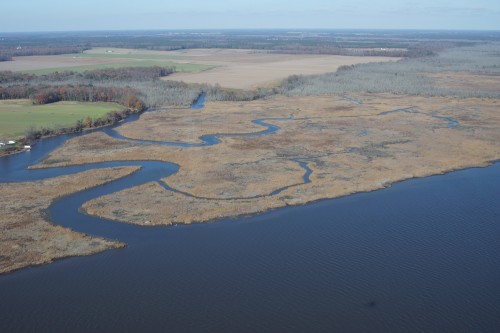Conservancy wins National Grant for Nanticoke Conservation
A conservation proposal developed and coordinated by the Chesapeake Conservancy has been awarded $1 million by the Department of Defense to conserve land in the Nanticoke River corridor, a part of Naval Air Station Patuxent River’s Atlantic Test Range. The award was made under the 2014 Readiness and Environmental Protection Integration Program Challenge (REPI) and is one of only two this year, and one of only three since the REPI Challenge began.
The Chesapeake Conservancy’s proposal includes the conservation of more than 2,000 acres containing a high biodiversity of flora and fauna, priority working lands, and areas important to the continued operation of Naval Air Station Patuxent River.
NAS Patuxent River is home to the Navy’s premier aircraft Research, Development, Test, and Evaluation facility and relies on the land, air, and sea ranges of the Atlantic Test Range to conduct its mission. The lands to be conserved through the REPI Challenge award will help reduce noise and safety concerns, and prevent costly restrictions and delays to training and testing.
In coordination with the REPI Challenge, the Naval Air Station has been identified as a Federal Sentinel Landscapes finalist. The Sentinel landscape program is a partnership between the U.S. Department of Agriculture (USDA), the U.S. Department of the Interior’s US Fish and Wildlife Service (USFWS), and the Department of Defense. Sentinel Landscapes are primarily working or natural lands where preserving the working and rural character of key landscapes strengthens the economies of farms, ranches, and forests; conserves habitat and natural resources; and protects vital test and training missions conducted on those military installations. If Naval Air Station Patuxent River is chosen as a Sentinel Landscape, the region supporting the base (including the Nanticoke corridor) will receive added focus, and potentially resources, from the USDA, USFWS, and Department of Defense.
Joel Dunn, executive director of the Chesapeake Conservancy, noted that the Nanticoke River is among the least developed of Chesapeake Bay tributaries and that several thousand acres in the watershed have already been protected.
However, Dunn said, “The conservation corridor is fragmented and the Chesapeake Conservancy’s Nanticoke Initiative, which the REPI grant will help support, is a plan to fill in missing pieces, particularly ecologically significant properties that might also provide public access to the Captain John Smith Chesapeake National Historic Trail, and protect the Atlantic Test Range.”
To carry out the project, NAS Patuxent River will work with the Chesapeake Conservancy, the USFWS, The USDA Natural Resources Conservation Service, Maryland and Delaware departments of natural resources, The Conservation Fund, and The Nature Conservancy. The REPI award of $1 million will be leveraged more than 5:1 with contributions from this partnership. The goal is to protect 2,259 acres of forests, wetlands, and farmland, as part of the Chesapeake Conservancy’s broader 8,500-acre wildlife corridor Nanticoke Initiative.
The Nanticoke initiative has been generously supported by the Mt. Cuba Center and the Longwood Foundation. The initiative’s large scale approach to conservation is critical to preventing landscape fragmentation and allows for the migration of species and habitats in the face of sea level rise, which is particularly important as the Nanticoke watershed is considered one of the most vulnerable areas in the nation, trailing only Louisiana and Southern Florida.
Ann C. Rose, President of the Board of the Mt. Cuba Center, said the conservation corridor includes diverse habitats, including a rare xeric sand ridge forest and Atlantic white cedar non-tidal wetlands. “This project will help keep the test range viable while it also protects communities of rare plants and the Nanticoke’s landscapes,” Rose said, adding, “Mt. Cuba Center, which has a particular interest in rare plants, was pleased to provide funding that will support this effort.”
In all, 124 rare, threatened, and endangered plant and animal species, including the federally endangered Delmarva Fox Squirrel, have been identified within the conservation corridor. The area is also part of the Nanticoke Important Bird Area and the internationally important Chesapeake Bay Estuarine Ramsar site, serving large concentrations of migratory waterfowl and Neotropical migratory birds.
Prior to this award, the Conservancy worked with its partners to conserve over 130 acres identified through the Nanticoke River Conservation Corridor Initiative. In February, the Conservancy partnered with the Delaware Department of Natural Resources and Environmental Control (DNREC) to conserve 114 acres of ecologically sensitive habitat west of Bethel, DE. In June, the Conservancy partnered with DNREC, The Conservation Fund, and the Nanticoke River Watershed Conservancy to conserve the 17.7 acre Chapel Branch Nature Area Moore Tract. This property will be owned by the Nanticoke River Watershed Conservancy and an easement created for the land will be held by DNREC. Maryland Department of Natural Resources Secretary Joe Gill said “Maryland has made significant investments in the Nanticoke Corridor, a landscape rich not only in natural habitats and living resources, but also rich in the history and culture of our state and its indigenous people. We look forward to building upon our success through the REPI program that allows us to partner on important conservation initiatives with organizations like the Chesapeake Conservancy, The Conservation Fund, and other state and federal partners.”
—
About the Chesapeake Conservancy:
The Chesapeake Conservancy’s mission is to strengthen the connection between people and the watershed, conserve the landscapes and special places that sustain the Chesapeake’s unique natural and cultural resources, and encourage the exploration and celebration of the Chesapeake as a national treasure. For information, visit www.ChesapeakeConservancy.org.
